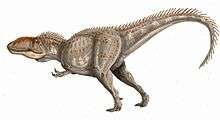Neovenator
| Neovenator Temporal range: Early Cretaceous, 125 Ma | |
|---|---|
| | |
| Restored skeleton | |
| Scientific classification | |
| Kingdom: | Animalia |
| Phylum: | Chordata |
| Class: | Reptilia |
| Superorder: | Dinosauria |
| Order: | Saurischia |
| Suborder: | Theropoda |
| Superfamily: | Allosauroidea |
| Family: | Neovenatoridae |
| Genus: | Neovenator Hutt, Martill & Barker, 1996 |
| Species | |
| |
Neovenator (nee-o-ven-a-tor) which means "new hunter" is a genus of allosauroid dinosaur. Since its discovery on the Isle of Wight, UK, it has become one of the best-known large carnivorous dinosaurs in Europe. Neovenator was at first considered possibly a new species of Megalosaurus.
Description


It measured approximately 7.6 meters (25 feet) in length, and was of a gracile build, weighting 1000–2000 kg.[1] Some fossils indicate a possible length of about 10 meters (33 feet), but these fossils are very fragmentary.[2] It lived during the Barremian stage (Early Cretaceous), about 125 million years ago.
Discovery and species
The first bones of the type species were discovered in 1978, in a plant debris bed within the variagated clays and marls of the Wessex Formation on the southwest coast of the Isle of Wight. It was much later (1989) that more bones from this specimen were found. Excavations undertaken by Dr Steve Hutt and his team have so far revealed approximately 70% of the skeleton.
Classification
At the time that it was described, by Steve Hutt, Martill and Barker in 1996, it was considered the only known allosaurid in Europe. However, further studies suggested it had more in common with the advanced carcharodontosaurid group of allosaurs, and several studies including a detailed examination of the species by Benson, Carrano and Brusatte in 2010 suggest that it is closely related to the Carcharodontosauridae (in a group called Carcharodontosauria), but is actually closer to the megaraptorans, together with them forming the family Neovenatoridae.[3] Other studies have supported Neovenator being a carcharodontosaurid, and megaraptorans being tyrannosauroids.
The cladogram below follows the 2010 analysis by Benson, Carrano and Brusatte.[3]
| Neovenatoridae |
| |||||||||||||||||||||||||||||||||||||||
| |
Cladogram after Novas et al., 2013[5]
| |
| ||||||||||||||||||||||||||||||||||||||||||||||||
| |
Location
Fossil remains of Neovenator have been found on the Isle of Wight (southern England), and were first discovered in the 20th century. Neovenator existed alongside Baryonyx, Polacanthus and Iguanodon in the early Cretaceous period. It was one of the top predators of its day.
Pathology
The holotype of Neovenator salerii had many pathologies. The authors of the genus list them as "midcaudal vertebrae fusions, healed fractures of mid-caudal vertebra transverse processes; osteophytes affecting pedal phalanges, healed gastralia rib fractures, some forming false joints... [and] scapula fracture."[6]
References
- ↑ "Neovenator - paleofiles.com".
- ↑ , Dodoson P, Weishampel D. B & Osmólska H, The Dinosauria, 2nd edition (2004), University of North Carolina Press, p. 104.
- 1 2 Benson, R.B.J., Carrano, M.T and Brusatte, S.L. (2010). "A new clade of archaic large-bodied predatory dinosaurs (Theropoda: Allosauroidea) that survived to the latest Mesozoic." Naturwissenschaften, 97:71-78 . doi:10.1007/s00114-009-0614-x
- ↑ Zanno, L. E.; Makovicky, P. J. (2013). "Neovenatorid theropods are apex predators in the Late Cretaceous of North America". Nature Communications 4: 2827. Bibcode:2013NatCo...4E2827Z. doi:10.1038/ncomms3827. PMID 24264527.
- ↑ Novas, Fernando E. (2013). "Evolution of the carnivorous dinosaurs during the Cretaceous: The evidence from Patagonia". Cretaceous Research 45: 174–215. doi:10.1016/j.cretres.2013.04.001.
- ↑ Molnar, R. E., 2001, Theropod paleopathology: a literature survey: In: Mesozoic Vertebrate Life, edited by Tanke, D. H., and Carpenter, K., Indiana University Press, p. 337-363.
External links
| Wikispecies has information related to: Neovenator |
| |||||||||||||||||||||||||||||||||||||||||
